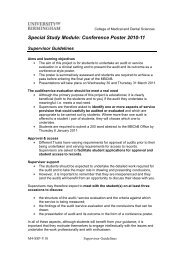Contents - College of Medical and Dental Sciences - University of ...
Contents - College of Medical and Dental Sciences - University of ...
Contents - College of Medical and Dental Sciences - University of ...
Create successful ePaper yourself
Turn your PDF publications into a flip-book with our unique Google optimized e-Paper software.
The 11 th International Workshop on KSHV & Related Agents, Birmingham, UK<br />
Virus-Cell Interactions I Abstract 22<br />
ANIMAL MODELS OF KAPOSI'S SARCOMA REVEAL A ROLE OF KSHV VGPCR AND<br />
RAC1 IN ANGIOGENESIS AND GENETIC INSTABILITY<br />
Lucas Cavallin 1,2 , Qi Ma 1 , Rui Zhang 1,2 , E. Margarita Duran 1,2 , Pascal J. Goldschmidt-<br />
Clermont 1 <strong>and</strong> Enrique A. Mesri 1,2<br />
1 <strong>University</strong> <strong>of</strong> Miami Miller School <strong>of</strong> Medicine <strong>and</strong> 2 Viral Oncology Program, Sylvester<br />
Comprehensive Cancer Center. Miami, FL 33136<br />
Abstract<br />
Kaposi’s sarcoma (KS) is a viral malignancy characterized by angiogenesis <strong>and</strong><br />
proliferation <strong>of</strong> KSHV-infected spindle cells. Spindle cells explanted from tumors lose<br />
KSHV <strong>and</strong> are not tumorigenic. However, tumorigenic KS cells could be isolated from<br />
advanced tumors where is more frequent to find cellular oncogenic alterations. We<br />
described a new animal model <strong>of</strong> KS (Mutlu et al. 2007. Cancer Cell 11:245-258):<br />
KSHVBac36-tranfected mouse endothelial lineage cells (mECK36) induce KSHV-infected<br />
KS-like tumors in nude mice, while mECK36 that lose the KSHV episome lose their<br />
tumorigenicity. shRNA silencing showed that vGPCR, a KSHV angiogenic gene<br />
upregulated in mECK36 tumors, is essential for angiogenesis <strong>and</strong> tumorigenicity. We<br />
found that mECK36 explanted from tumors that lose the KSHV episome are tumorigenic,<br />
indicating that, as KSHV tumorigenesis progresses in vivo, the malignant phenotype<br />
becomes irreversible <strong>and</strong> KSHV-independent. Explanted mECK36 displayed 3 times more<br />
foci <strong>of</strong> DNA repair than cells never grown in tumors indicating that DNA damage is<br />
increased in vivo. We now find that expression <strong>of</strong> constitutively activated Rac1, a<br />
mediator <strong>of</strong> vGPCR pathogenesis over-expressed in KS lesions, is sufficient to induce KSlike<br />
tumors in transgenic mice by a mechanism involving PTEN inactivation <strong>and</strong> R.O.S.mediated<br />
oxidative DNA damage. These results points to a key role for Rac1 induced<br />
R.O.S. production in KS pathogenesis. They indicate that in addition to angiogenesis,<br />
vGPCR activation <strong>of</strong> Rac1 can increase mutation rate to foster a multi-step carcinogenesis<br />
process driven by oxidative genetic damage.<br />
Presenting author Email: emesri@med.miami.edu<br />
45















